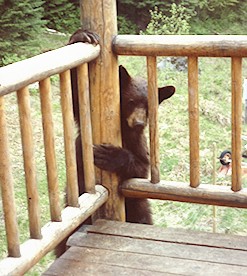Robin Redbreast-part Four. (Two weeks out of the nest.)
We thought we had lost one fledgling, but later came to learn that they easily blend into the landscape of our yard. And we now believe that all three of our babies have survived quite satisfactorily, despite our efforts. And my worst fears were not confirmed.
The cherry season is almost over, but the robins have had their fill for the past two or three weeks. After the fledglings have left the nest, the robins began harvesting cherries, even though they were not entirely ripe.
The way they harvested the cherries was quite unique: the adults would fly up into the tree, pick the cherries and drop them on the ground. After flying back down to the ground, they would pick them up and stuff them into the eagerly waiting mouths of the young fledglings, who would typically take one bite and spit cherry out. The mommy would then patiently pick a cherry up again and feed her fledgling another bite. This would go on and on until her baby had consumed the whole cherry.
She continued performing this task patiently for most of the morning until all three of her fledglings had their fill. Luckily the daddy usually helped by feeding another baby. The fledglings would remain on the ground and excitedly rush over to the cherries as they fell from above. And begin with their behavior of wiggling their bodies, and opening their mouths; doing all they could to ensure that mommy or daddy would feed them.
From along the back fence, enters a baby squirrel. He almost immediately discovers this is a great deal! All he needs to do is stand on the ground under the tree and wait for the cherries to be delivered to him.
But there seem to be enough cherries for all these creatures to have their fill. Our robin family has staked out our back yard and protected it from most other intruders. They feel safe here; have found plenty of food, including cherries, worms and strawberries. We’re hoping this will continue.
The youngsters are fully feathered, but still have the speckled juvenile appearance. They seem to spend most of their time and in our yard, where they have not only food, but also water and several birdbaths, plenty of trees that providing camouflage to protect them from possible enemies.
It’s so great to see all three of them acting cute sitting in the strawberry patch waiting for momma to come and feed them.
Now the male seems to be displaying some courting behavior. Again, we are waiting for the robins to patch up the nest, in anticipation having a second brood this season. The nest, however has been frequented by several sparrows and finches who have for reasons unknown to us, attempted to throw some things out. They do sometimes chirp loudly and seem to be trying to attract a mate. But the robins have responded by repeatedly chasing these other birds from their nest.
We anticipate that the mother Robin will stop feeding the babies and become broody again. Meanwhile, the male robin continues to patrol and protect his territory, our yard. No other robins are welcome here.
Stay tuned…
